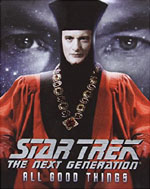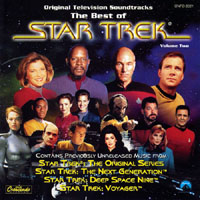All Good Things....

|
Anticipation for a really grand two-part finale to this hit series
reached phenomenal heights just before this story was first
broadcast. In terms of character, the story pulled a brilliant stroke
in merging the crew's present time with both the past of
the pilot episode
that allowed them to bring back some favourite characters,
and a future that showed what might happen to them all
25 years hence. A grand idea. But Star Trek once more
stepped into time travel to accomplish this, and ended up with
something icky stuck to its boot. The writers themselves really
never did a good job of wrapping their heads around their temporal
creation, making Q's comments about where the real exploration is
seem a bit off the point. They might have been better off studying
a nebula - in fact, from the graphics we get, it looks as if they
did.
|
Okay, let's cut right to the biggest and most obvious brain fart in
the whole piece. Our temporal phenomenon, which unsurprisingly
looks like the usual Brannon Braga cloud in space, is formed by
the convergence of inverse tachyon pulses in three separate
time zones, all of which are fired by a ship at the request of
the Jean-Luc Picard on board. And we know that this thing is growing
backwards in time, therefore it's bigger in the past and smaller
in the future. But now, think about what this really means
for the future time zone all on its own. The cloud should be
visible before the tachyon burst here, because it grows backwards
in time, and it should not exist at all after the tachyon pulse,
because it does not grow forward in time.
On screen, we are shown the opposite. Cause and effect
should be in a different order for the cloud versus our characters,
yet the writers didn't get it in time to put that into their script.
Of course, this kind of dual direction narrative can be a real pain
in the butt to make work. For my money, the season two
"Sliders" episode
"As Time Goes By" did a somewhat
better job of it, without really getting everything right there
either.
"Discontinuity"
There are other problems like this scattered throughout the story
as well. The earliest time period has the Enterprise divert
from the Farpoint mission to go to the Devron system, yet the
crewmembers of the main story's "present" time period have no memory
of doing so. This seems to indicate that each time period is
on a separate branch of time. So how does the cloud reverse
through all of these time periods, while still missing the
one that only appears in the story's coda?
The episode plays it a bit fast and loose with memory as well.
At one point, Dr. Crusher scans Picard's brain and notes that
he has gained two days
worth of memories in just a few seconds, which we know represents
the experiences he's just had in the other two time periods.
Which gets me thinking.... if he suddenly finds himself in the
future, and an extra 25 years of political changes,
character developments and technological advancements are
suddenly part of his memory, how might that affect his brain,
and how much of that does he bring back with him into the
present, or the past? It's quite a fortuitous writing crutch that
his future self has some future version of Alzheimer's.
Another problem has the feel of a leftover from a previous draft
that didn't get revised when it should have. At one point,
Data (from the "present"?) figures out that there are three
inverse tachyon pulses coming together that all seem to have
come from the Enterprise. But in the "future" that we witness,
it is Beverly's ship the Pasteur that fires the pulse,
not Admiral Riker's Enterprise. On the other hand, this could
indicate that in some alternate future, it is Riker's Enterprise
that triggers the pulse that coincides here. But that expands
the scope of the phenomenon beyond anything that our crew
is seen to investigate.
Playing for Stakes
My ultimate beef with this story boils down to just one real
question. Just what the hell is REALLY at stake here?
Perception of that answer shifts radically from one point of the
story to another. I have to say, though the first episode seems
a bit too slow for its own good, it leaves off in a REALLY good
place, largely because Q does such a good job of dropping all
the right clues and riddles and hints to make you think the
stakes are HUGE. The trial begun in
the pilot episode is still on,
and this is a conclusion to a seven-year question.
Humanity's wisdom and philosophy and intelligence are being
tested. They are about to cause catastrophe instead....
and they've done it before, and they'll do it again....
making it sound like some kind of habitual pattern that they
can't break out of even if they wanted to. Then the two-part
version sticks its cliffhanger right there, and the viewer
cannot wait to see what will unfold in part two. Clever.
The stakes seem huge.
Only in part two does the phenomenon that grows backwards in time
reveal itself. It looks like it is about to stop all life in
the galaxy from forming in the first place.... but in what
percentage of the infinite number of possible different timelines?
Really, if you pick any of the three major time/space/choice
periods that Picard visits in this adventure, the galaxy is
populated by all the usual races, and the phenomenon gets
smaller as they all move into the future, and about 25 years
after the "present", it will disappear entirely. So....
what's really at stake in any of those periods?
Recently I compared my oft-watched two-part version of this story
with my rarely-watched all-in-one first broadcast version
where I had missed the first 30 minutes desperately trying to find a channel
that was actually bringing this "special TV event" in May 1994.
As I suspected, the need to re-cap part one and show
another title sequence eats up some extra running time,
which means that there are a number of scenes in the second half
of the adventure that had been cut out of the two-part version,
scenes that now seemed and felt to me either extended or brand new.
In particular, one of the sickbay scenes seems to have really needed
the extra footage before Picard enters
of Geordi incapacitated in bed and Ogawa losing her baby
in order to sufficiently emphasize a certain weird idea of growth reversing itself
as time moves forward, and get that idea to pop for me consciously
as a partial answer to what was at stake.
Time is really colliding with "anti-time", smashing up, and going haywire, eh? Hmmm.
And yet it still misses the time period of the coda....
In fact, it doesn't seem to operate in the Yar/O'Brien past
or the Pasteur future either. I'm not convinced this is explored
enough or properly, but it's an improvement.
I've gotten into the habit of excusing a lot of the dialogue
explaining temporal phenomena in Star Trek, because the dialogue
and the characters' understanding of such things is usually
ludicrously limited and often informs poor philosophical choices.
If the events themselves as shown on screen can be explained
in more acceptable ways, a Star Trek story can get a
caveated pass from me anyway. Yes, there are other possible
explanations for what we see here that can make better sense
of it all. But this story won't get a pass so easily,
precisely because Q makes such a pivotal speech about how
the understanding of such phenomena is what humanity's real
growth should be all about. So, the fact that pretty much all the
dialogue treats time as one big rewriteable line, with
discontinuities that they can't begin to account for,
I'd have to say Picard's crew didn't score so high on the
understanding meter, while Moore and Braga
seemed to have understood it even less.
Worst of all, the idea is really most at home in an anthology
series like "The Twilight Zone", where all you have to do
is discover the mess, and you can profoundly leave your protagonists
stuck in it forever, thus leaving your audience thinking.
But because, even for a finale, this is still a continuing franchise
with a lot of studio money invested in it, the writers must still
put their toys back and clean their room before bedtime.
So they magically hit the reset button, and it was all as if
nothing had happened.
Maybe Picard just dreamed the whole thing. If so, this story helps
perpetuate one of the stupidest clichés for exiting a dream:
suicide. Could they really think of nothing better than blowing
up all three Enterprises, plus the Pasteur? This involves more
discontinuity, because if the earliest Enterprise blows up
and takes Picard and crew with it, they won't be around to blow up
again in the present, and again in the future. If these are
separate timelines without a common root, you've missed a key
part of the exploration of the phenomenon once more. Exactly
how does it grow backwards in time if it can't follow a branch
of time back to its common root? And really, if Picard can blow
himself and his ship and crew up three times and still come out of it,
what the hell was really at stake?
I think I'd have much preferred a solution to the episode's puzzle that
did not involve destroying the Enterprise(s), which had been done and annulled
so often already that it just seemed like a lazy way to attempt to create excitement.
In particular, I think it should be most important that the middle, present-day
Enterprise should survive, and continue into the coda, with the characters we continue
to follow having all experienced this adventure along its middle time-period.
Actual events, investigations, and learnings to add to the canon.
A big part of what it's all about, according to Q, n'est-ce pas?
That one move could have really improved this adventure's ranking in my book.
A story's final fix is a big element in how I rate it, and I'm not that impressed
by loads of technobabble, huge explosions with annulled impact, and a complete reset of everything.
Lazy and unimpressive.
But, but... if the Enterprise(s) don't blow up,
then what else do you do to make the ending exciting? Well, there is one Romulan warbird
in there with them investigating the present-time anomaly, a warbird
that everyone seems to have conveniently forgotten about. Use it somehow;
be creative. Tomalok is such a great adversary/rival for Picard, it's boggling
how underused he was both in this story and in the rest of TNG as a whole.
I wish he could have got more to do, and that his presence could remain canon
instead of "alternate universe". Indeed, actor Andreas Katsulas is credited on
both parts 1 & 2, even though his one and only scene is in the second half.
As for some of the other scenes that only show up in the all-in-one
movie length version of the adventure, the one that got the biggest
eye-popping reaction from me was the scene where Q showed up
as an old man. Very bizarre, and reinforcing the idea that
he is trying to mirror Picard at every opportunity for some
strange reason. No doubt this was dropped because Q here
merely gives us the same information we had got earlier in the show.
The best "so-forgotten-it's-new-to-me" pop-up scene
though has to be the extension of the wrap-up between Picard and Q
in the courtroom. If you can believe it, the two-part version leaves
out the bit where Q admits his responsibility in making the entire
conundrum possible, which, if you think about it,
makes the conundrum hypocritical as a test of Humanity,
the Federation, or anything outside of the Q continuum itself.
Also interesting is the "added" tidbit of the differences of opinion
that John de Lancie's Q apparently had with the rest of the Q
concerning all this. These bits really shouldn't have been dropped
from the two-part version, as they help clarify a lot.
In fact, they nicely re-inforce my central opinion of the whole thing,
that perhaps this entire adventure along with its biggest threat, up to this point,
only really happened in the minds of Picard and the Q,
if indeed those really are separate minds....
|
And now, the coda. As we move forward into The Next Generation
feature films, and Deep Space Nine and Voyager, what can we
say actually happened in this adventure, in our timeline?
Worf and Troi almost kissed, Picard ran around in his nightgown
apparently for nothing, and he sat in on his first poker game
with the rest of his crew.
The only real events happen in the coda. "All Good Things...."
has to be the biggest,
most hyped "Adventure That Never Really Happened" in sci-fi
history. They never even really went to the Devron system
to have words with Romulan Commander Tomalok, not really.
This is all very sad. I do like the final scenes very much.
I just wish more had actually happened. Was anything ever
really at stake?
Perhaps all we really get is a bit of understanding. The
Riker-Troi-Worf triangle seems to move to a better place
(also known as oblivion),
and that perhaps is something. But... was it really going
anywhere before that is different to where it ends up,
if what we saw in this future was no more accurate
than any of the other alternate timelines we witnessed
in the story "Parallels"?
I'm also looking at John de Lancie's Q,
arguably the most interesting character in this piece,
and more and more I'm thinking he is actually
some repressed figment of Picard's own consciousness,
the jovial, playful, rude side that he keeps hidden, somehow exploding
and coming out to taunt him and test his philosophy,
every day, nonstop. THAT may be worth exploring far more
than failed temporal theory or nebulas. That theory has
never felt more right in any other adventure... possibly because
this adventure has been relegated exclusively to Picard's mind.
|
|
The largest swath of music from Dennis McCarthy's score
for "All Good Things..."
is available here:
|
|
So, yes, this story is entertaining, but ultimately feels
quite trivial and underwhelming, causing me to look back
to previous recent episodes to find
the last true television adventure of our Enterprise D and crew.
|
|










 (regular)
(regular)



